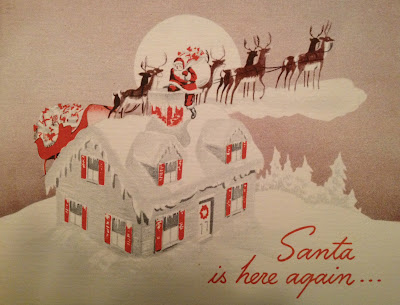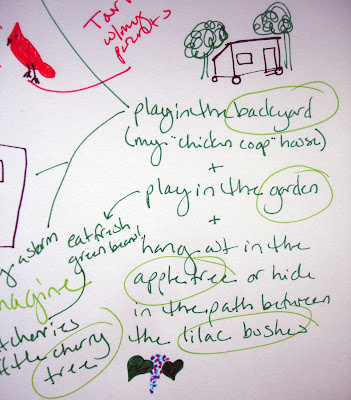This post is the third in a series on what I
call the Creativity Tool Kit and focuses on a non-traditional creativity
tool, the habit of keeping a gratitude journal.
The tools in the Creativity Tool Kit themselves are a series of
essentially low-key activities that have a big impact on creativity. Their purpose is to both cultivate a habit of
nurturing creativity and to bring our attention to the present with a sense of
curiosity. Individually, they can spark strong ideas, but used in sync they
become a natural spring for creative thinking.
I have listed ideas for applying or practicing with the tool at the end
of the post.
Creativity keeps you honest. With the ability to have a handy supply of
ideas and solutions at the ready, creativity makes it possible to solve
challenges and keep moving forward; your goals glowing and glittering on the
horizon growing closer and closer. So it
was difficult to ignore the fact that when my over-booked fall schedule reached
a sudden lull and I came back into myself, I realized I couldn’t blame my several-week-long
avoidance of the Creativity Tool Kit exercises on my busyness. My symptoms were classic: huge inertia
regarding doing Morning Pages; avoidance of yoga; jittery energy; irritability;
an overwhelming desire to sit like a blob; a mind that felt like mush; and an uncontrollable
stream of tears running down my face when I watched contestants on shows like
The Voice reach for their dreams. Having
been there before, I knew that I was on the fast track to Burn Out. Worst of all, when I looked towards my career
dreams and goals it was like the lights had gone out. I felt like I had gotten turned around in the
desert and was looking at acres of dunes in the moonlight with no clear sense
of direction.
I needed a toe hold to get back on track, but I felt
resistant to everything that I usually loved doing that made my brain feel
fresh and clear. When I would go for a
walk my mind would tell me I was taking too much time; going to the gym was like
wading through molasses; forget even contemplating an artist date, there was no
energy for them; and Morning Pages/free writing was either lack luster or sporadic
and angry. I mentally berated myself, a
creature of habit and consistency, for being weak willed and having lost my
discipline. It felt like an endless
circle and it was not long before the usually very healthy me got miserably sick. Realizing that I needed to be gentle with
myself, I did some negotiating with my battered, grumpy and unhappy self and we
decided that the one thing we could use more of is thinking about are all the
moments in the day that bring us joy, and the people and circumstances associated
with them.
The human brain (and our ego) loves to fight injustice, be
right and be righteous—which is why we tend to dwell on negatives. They are not always easy to understand, or we
feel we can find a way to correct them. It
is well known in customer service-oriented brands that a happy customer will
tell three other people about a positive sales experience. On the other hand, an unhappy customer with a
poor customer service story to share will tell nine or more people. Forget for a moment about what that means for
retailers; contemplate how much time it takes to tell and retell that story to
nine-plus people! And consider the
emotions it brings up, that you hope to have validated, every time you recount
it. We do the same thing with our day
and the negative experiences we are feeling.
So I agreed with myself that I would go back to basics
and be consistent about keeping a gratitude journal. I would write in it before bed and I would
focus on the positive moments in my day.
There would be no “buts” only happy memories, meaning that I could write
“I really enjoyed the extra cheese and pepperoni pizza and glass of red wine
for dinner tonight” and was not allowed to write “but I really should not have
eaten that.” Only the things that made
me happy could be written down and as I documented those moments, they blossomed
into the reason those things made me happy.
So while I may have enjoyed the pizza, it was really the fact that my
boyfriend and I had uninterrupted time in our schedules together to share a
pizza, lounge on the couch and watch one of our favorite TV shows.
Writing about happy things made the gratitude journal
slightly addictive. I kept it on the
nightstand with one of my favorite pens.
Even when I would crawl into bed in the wee hours of the next day, I
would reach for it and write. I also found
myself during the day mentally noting the moments that I wanted to remember to
write down.
The gratitude journal, although significant in its own
right, was really a vehicle to building my confidence back up that I could be
devout and consistent again with my creativity routine. I just needed small steps that would allow me
to emotionally prepare to return to Creativity Tool Kit activities, such as
Morning Pages, and address some of the larger issues I was experiencing such as
feeling like I was no longer making progress towards my goals, no longer
learning and being challenged on a daily basis, and that I was in need of some
big (and scary) change.
While not a classic Creativity Tool Kit item, a gratitude
journal is cited as a key element to living an authentic life in books such as
Simple Abundance by Sarah Ban Breathnach and was enthusiastically adopted by
Oprah a few years ago. For a long time,
my personal attitude towards gratitude journals was similar to that of author
Gretchen Rubin in her book
The Happiness Project. Rubin tried keeping a gratitude journal as
part of her year-long experiment in happier living. At a point of reassessment mid-year, she deemed
she was fine without the gratitude journal.
While I was familiar with the practice of keeping a gratitude journal,
my challenge was that I couldn’t get it to stick. This make sense when I consider that when all
of the other items in the Creativity Tool Kit are in full-swing it is very easy
to feel happy, clear minded and able to keep a balanced perspective on both the
good and challenging things that happen in a day (or life). When that is the case a gratitude journal can
feel redundant. Creativity also gives us
momentum towards our goals, which gives us the feeling of, while maybe not
being “in control” the feeling that we know how to sail our boat on the many
surfaces of the sea.
Yet, I was really happy to have this particular “tool” in
my Creativity Tool Kit, because when the going got rough, it was exactly the
item I needed to ground my thoughts and start re-orienting myself. It has been 67 days since I returned to
keeping a gratitude journal and there have been some major positive changes in my
life—and my mood. I can attest that not
many of the decisions for change have been easy ones, but the gratitude journal provided a way back to
knowing myself and the creativity tools that have given me the courage to take
the steps towards the horizon where I can see my goals glittering once again.
If keeping a gratitude journal sounds like something you’d
like to explore, here are a few tips to get started:
·
For a gratitude journal, I recommend selecting a
small notebook or blank journal that delights you. It should not feel intimidating and should invite
casual, happy thoughts. For my gratitude
journal, I indulge in books with textured covers, colorful stitching, even some
sparkle—everything my traditional “for posterity” journal is not.
·
Keep your gratitude journal, along with a pen
that you like, next to your bed.
·
Set a time, such as before bed, that you can
review your day and list your thoughts.
·
Don’t worry about structure. Some days you may want to write paragraphs
and other days you may scratch out a bullet list. Write in the way that comes at that moment.
·
Don’t make it too precious. Just like all the tools in the Creativity
Tool Kit, a gratitude journal is a vehicle to open up your thinking and enhance
your awareness. The goal is to be
consistent, not perfect.
·
While it is a “gratitude” journal, don’t
hesitate to explore that space between happiness and thankfulness. Knowing moments where you felt joyful or wise
or able to overcome obstacles are all open to inclusion.
·
As my gratitude journal is next to my bed, I
also keep space in it for meditations, interesting thoughts, goals, dream
images, and general musings. Overall,
though I try and keep the items I jot down in it short, sweet and upbeat.
Having just expressed our appreciation during the
Thanksgiving holiday, it is a great time to experiment with keeping a gratitude
journal. I would enjoy hearing your
thoughts and experiences especially if you have kept a gratitude journal, keep
one, or are just starting. Share your
thoughts here on The Paper Compass.
For other posts on The Creativity Tool Kit see:








.JPG)
.JPG)



































